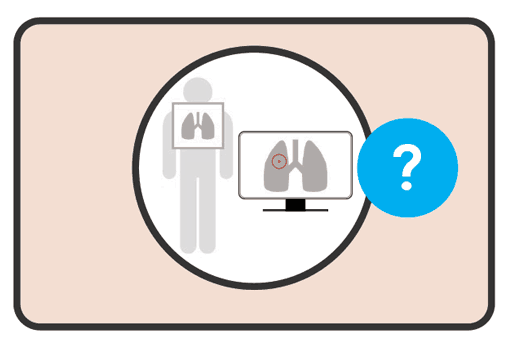Book traversal links for 3.1.3 CAD technologies for screening and triage

CAD software packages have been introduced to automate interpretation of digital CXR images for pulmonary TB diseaserelated abnormalities. CAD products analyse digital CXR images and generate a continuous numerical score that corresponds to an increasing likelihood of TB as the score increases. It should be noted that the scores are usually between 0 and 1 or 1 and 100 but are not percentages, and they should not be interpreted as directly reflecting the risk of TB.
CAD can resolve numerous difficulties in human interpretation of CXR. These include the lack or scarcity of trained health personnel to interpret radiographic images for TB screening and substantial intra- and inter-reader variation in correct detection of abnormalities associated with TB. CAD could thus allow significant scale-up of TB screening and increase access to CXR screening. The score given by CAD when reading a chest film relates solely to the likelihood of TB; in contrast a human reader can identify between multiple pathologies simultaneously when interpreting a CXR.
The performance of three CAD software programmes – all of which were on the market by January 2020 and had received a CE mark¹ – were evaluated for the update of the TB screening guidelines. The performance of the class of software was assessed in multiple external evaluations against a library of digital radiographs and associated clinical data, independently of validation studies conducted by the product manufacturers themselves. These evaluations indicated that CAD software programmes are accurate and their performance compares well with human interpretation of CXR for detection of pulmonary TB disease.
The recommendation that CAD software programmes be used in place of human readers for interpretation of digital CXR in screening and triage for TB disease applies to software brands that are found by external evaluation to have a performance that is not inferior to that of the products reviewed by the Guidelines Development Group in 2020. It should also be noted that the recommendation is specific to adults and adolescents aged 15 years and older and applies only to interpretation of antero-posterior or postero-anterior views of digital plain CXR for pulmonary TB.
If a programme includes use of CAD for automated interpretation of CXRs as part of screening or triage, it is essential that calibration be conducted to determine the appropriate threshold score for any given setting and programme according to the spectrum of radiographic findings in members of the target population with and without TB disease. Section 4 describes a toolkit for implementation and calibration of CAD technology for screening and triage, including a protocol and guidance for conducting a CAD calibration study and a web-based tool to facilitate analysis of data, calculation of receiver operator characteristics (ROC) curves, the accuracy of different thresholds and interpretation of findings.
Considerations for implementing CAD technology for screening or triage
- Implementation of CAD will require thorough consideration of the infrastructure requirements, including digital radiography equipment, electricity, computer availability, Internet access, and the fees for use and the cost of the licence for the CAD products. The resources required and cost– effectiveness will depend on the setting, including the current availability and salaries of human readers.
- Although CAD technologies can reduce the burden on human readers, maintenance of human reader capacity for TB screening radiography is essential, for example for children aged < 15 years for whom CAD is not currently recommended or for interpretation of abnormal images when a disease other than TB is suspected.
- The abnormality score thresholds recommended by the manufacturer, when available, do not perform uniformly in different contexts. Users may also differ in their preferences for higher sensitivity or specificity, depending on their circumstances or objectives of screening (e.g. desire to maximize case detection rather than reduce false-positive screening test results). CAD software should thus be calibrated for each setting or population in which it will be used for screening.
- After initial calibration, monitoring and analysis of CAD performance should continue. This may include assessment of consistency with human reader interpretation, proportion of images read as abnormal and requiring further investigation and the proportion of patients with images read as abnormal who have bacteriologically confirmed TB.
¹ CAD4TB v6, from Delft Imaging; Lunit Insight CXR, from Lunit Insight; and qXR v2, from Qure.ai
 Feedback
Feedback